
A pulley is a wheel on an axle or shaft enabling a taut cable or belt passing over the wheel to move and change direction, or transfer power between itself and a shaft. A sheave or pulley wheel is a pulley using an axle supported by a frame or shell (block) to guide a cable or exert force.

In science and engineering, the weight of an object, is the force acting on the object due to acceleration or gravity. According to International Organization of Legal Metrology result of weighing is mass for technical and scientific purposes while conventional value known as conventional mass for other purposes. In imperial world mass means weight in vacuo while conventional mass means weight in air . Some standard textbooks define weight as a vector quantity, the gravitational force acting on the object. Others define weight as a scalar quantity, the magnitude of the gravitational force. Yet others define it as the magnitude of the reaction force exerted on a body by mechanisms that counteract the effects of gravity: the weight is the quantity that is measured by, for example, a spring scale. Thus, in a state of free fall, the weight would be zero. In this sense of weight, terrestrial objects can be weightless: so if one ignores air resistance, one could say the legendary apple falling from the tree, on its way to meet the ground near Isaac Newton, was weightless.

A lever is a simple machine consisting of a beam or rigid rod pivoted at a fixed hinge, or fulcrum. A lever is a rigid body capable of rotating on a point on itself. On the basis of the locations of fulcrum, load and effort, the lever is divided into three types. It is one of the six simple machines identified by Renaissance scientists. A lever amplifies an input force to provide a greater output force, which is said to provide leverage, which is mechanical advantage gained in the system, equal to the ratio of the output force to the input force. As such, the lever is a mechanical advantage device, trading off force against movement.

A trebuchet is a type of catapult that uses a rotating arm with a sling attached to the tip to launch a projectile. It was a common powerful siege engine until the advent of gunpowder. The design of a trebuchet allows it to launch projectiles of greater weights and further distances than that of a traditional catapult.

Troy weight is a system of units of mass that originated in 15th-century Kingdom of England and is primarily used in the precious metals industry. The troy weight units are the grain, the pennyweight, the troy ounce, and the troy pound. The troy grain is equal to the grain unit of the avoirdupois system, but the troy ounce is heavier than the avoirdupois ounce, and the troy pound is lighter than the avoirdupois pound. One troy ounce equals exactly 31.1034768 grams.

A counterweight is a weight that, by applying an opposite force, provides balance and stability of a mechanical system. The purpose of a counterweight is to make lifting the load faster and more efficient, which saves energy and causes less wear and tear on the lifting machine.

A crane is a machine used to move materials both vertically and horizontally, utilizing a system of a boom, hoist, wire ropes or chains, and sheaves for lifting and relocating heavy objects within the swing of its boom. The device uses one or more simple machines, such as the lever and pulley, to create mechanical advantage to do its work. Cranes are commonly employed in transportation for the loading and unloading of freight, in construction for the movement of materials, and in manufacturing for the assembling of heavy equipment.
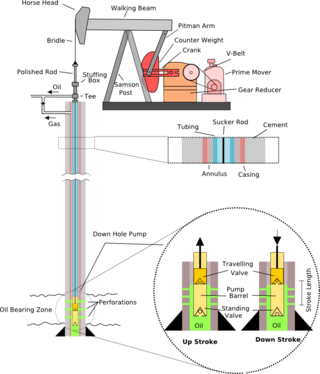
A pumpjack is the overground drive for a reciprocating piston pump in an oil well.
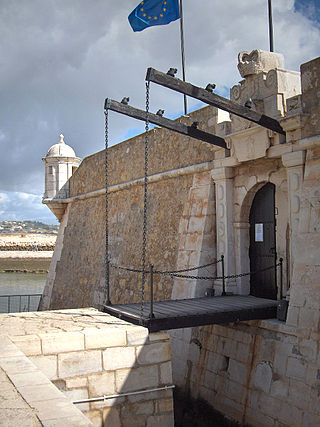
A drawbridge or draw-bridge is a type of moveable bridge typically at the entrance to a castle or tower surrounded by a moat. In some forms of English, including American English, the word drawbridge commonly refers to all types of moveable bridges, such as bascule bridges, vertical-lift bridges and swing bridges, but this article concerns the narrower historical definition of the term where the bridge is used in a defensive structure.
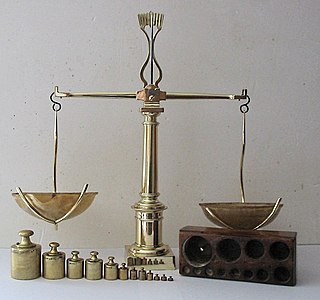
A scale or balance is a device used to measure weight or mass. These are also known as mass scales, weight scales, mass balances, and weight balances.
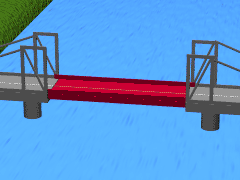
A vertical-lift bridge or just lift bridge is a type of movable bridge in which a span rises vertically while remaining parallel with the deck.

A fly system, or theatrical rigging system, is a system of ropes, pulleys, counterweights and related devices within a theater that enables a stage crew to fly (hoist) quickly, quietly and safely components such as curtains, lights, scenery, stage effects and, sometimes, people. Systems are typically designed to fly components between clear view of the audience and out of view, into the large space, the fly loft, above the stage.

The Roberval balance is a weighing scale presented to the French Academy of Sciences by the French mathematician Gilles Personne de Roberval in 1669.
The history of measurement systems in India begins in early Indus Valley civilisation with the earliest surviving samples dated to the 5th millennium BCE. Since early times the adoption of standard weights and measures has reflected in the country's architectural, folk, and metallurgical artifacts. A complex system of weights and measures was adopted by the Maurya empire, which also formulated regulations for the usage of this system. Later, the Mughal empire (1526–1857) used standard measures to determine land holdings and collect land tax as a part of Mughal land reforms. The formal metrication in India is dated to 1 October 1958 when the Indian Government adopted the International System of Units (SI).
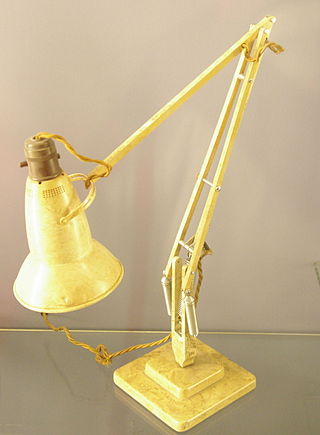
A balanced-arm lamp, sometimes called a floating arm lamp, is a lamp with an adjustable folding arm which is constructed such that the force due to gravity is always counteracted by springs, regardless of the position of the arms of the lamp. Many lamp brands, as well as other devices, use this principle.

In common usage, the mass of an object is often referred to as its weight, though these are in fact different concepts and quantities. Nevertheless, one object will always weigh more than another with less mass if both are subject to the same gravity.
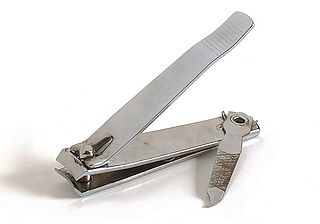
The compound lever is a simple machine operating on the premise that the resistance from one lever in a system of levers acts as effort for the next, and thus the applied force is transferred from one lever to the next. Almost all scales use some sort of compound lever to work. Other examples include nail clippers and piano keys.
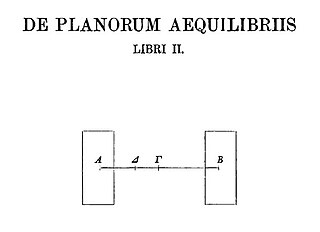
On the Equilibrium of Planes is a treatise by Archimedes in two books. The first book contains a proof of the law of the lever and culminates with propositions on the centre of gravity of the triangle and the trapezium. The second book, which contains ten propositions, examines the centres of gravity of parabolic segments.

A double-beam drawbridge, seesaw or folding bridge is a movable bridge. It opens by rotation about a horizontal axis parallel to the water. Historically, the double-beam drawbridge has emerged from the drawbridge. Unlike a drawbridge, a double-beam drawbridge has counterweights, so that opening requires much less energy.
Since ancient times, traditional mathematics in Ethiopia have related to various aspects of astrology, the calendar, and measurements of physical properties such as length, weight, and distance. Ethiopians used alternate units of measurement which differ from fundamental law; traditionally, scaling and counting values have been described using draft animals such as goats, mules, sheep, or camels, and in modern times, steelyards.
























